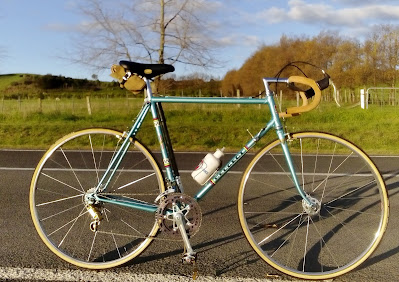Over the past few years I have been thinking about how to build up
the most comfortable modern era classic/vintage steel race bike with
a reasonably short wheel base without to much fork rake etc
(Some say this modern geometry was standardized by
Ernesto Colnago in 1968 with his iconic Colnago Super frame)
...another good link for Colnago Super here.
The test bed bike I decided to use is my Peugeot PY10 for reasons
that will soon become clear...so the first obvious step was to run
some 25mm Vittoria G Corsa tubulars, as I had been told by reliable
sources that these rather expensive tyres offer unparalleled comfort
and performance.
I have been running two sets for about the past couple of years and
can personally confirm all those positive recommendations....
they are without doubt the best tubular tyres I have used.
The PY with 25mm Vittoria Corsa tyres on a 24h wheelset that I
believe are ex Luis Ocaña (more about that sometime).
So The PY was now riding very smoothly, soaking up lots of that
awful road noise that New Zealand roads are rightfully notorious for,
but I have another item hanging in my workshop that I was hoping
would really turn the bike into a super comfortable ride, while
remaining pretty close to period correct.
Long ago I had seen a photo of Herman Van Springel contending
the 1968 Paris–Roubaix with Merckx, his bike running wooden rims..
bikes, but I had mainly used a new narrow width set that Italian
be a bit of a mistake on my part.
They need to be trued up pretty tight or they would go out of
alignment pretty damn quickly which resulted in various
complications too boring to go into here.
well to avoid engaging in light bike chat!
68' Paris- Roubaix, I realized that of course some riders would
race as the Roubaix.
phased out in the late 1960's, possibly early 1970's.
+tied and soldered to Maillard 700, Professional hubs in France,
which I of course, can't confirm, though that being said, it is hard
to imagine any other reason for building a racing wooden
wheelset in the 1970's?
brake pads, I had lazily used normal red and black rubber blocks
on previous wooden wheel sets which soon left a heavy ring of
unsightly rubber on the sides of the rims.
It was a pretty straightforward process cutting and shaping a set of
blocks from unused corks and finishing them with a couple of
coats of shellac.
25mm Vittoria's and the woods have made this without doubt the
most rider friendly 1970's (almost) period correct
something about them always adds a subtle touch of the serious
to any classic racing bike.

Notice that there is not that ring of rubber that is left with rubber
blocks, the red ring on the rim is a factory insert.
Jacques Anquetil en la Paris-Roubaix. 1959 on woods.
to that is they didn't seem to have slowed Van Spingel down too
much over the 264km of the 1968 Paris-Roubaix....second to Merckx
Some nice footage here from that 1968 Paris-Roubaix.
regular mounts.
about before researching the background to this build...apart from
his loss on the last stage of the 1968 TdF to Jan Jassen, there was
much much more to him than that, including a record seven
A great rider during a period of great champions.























